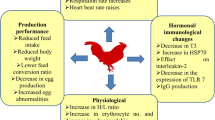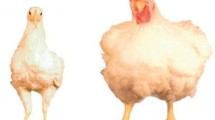Abstract
Six trials with ringed turtle doves (Streptopelia risoria) explored the combined effects of food restrictions and DDE [1,1,-dichloro-2,2-bis(p-chlorophenyl) ethylene] on reproductive performance and body condition. In each trial, eight groups of eight breeding pairs were either exposed (four groups) or not exposed (four groups) to DDE and held on either 100, 90, 80, or 70% of normal food intake. Three performance trials and three condition trials were conducted. In each case, the three trials differed only in the time food was restricted—either 2 weeks before pairing, at pairing, or at egg laying. Performance trials assessed reproductive performance and were continued for about 42 days, the normal period required to fledge young. Condition trials were each terminated at the time most pairs failed in the corresponding performance trial. Pairs were then sacrificed to assess their body condition. In performance trials, treatments severely affected breeding success. Overall, in the three trials, productivity in clean birds was reduced 50, 85, and 100%, respectively, at food intakes of 90, 80, and 70% of normal. Effects were greater on DDE birds; productivity was lowered 23, 87, 98, and 100% at 100, 90, 80, and 70% food intake, respectively. The timing of food restriction was as important as its intensity. A 10% reduction in food before pairing had a greater effect on overall performance than a 30% reduction at egg laying. DDE effects were greatest in birds subjected to food restrictions before egg laying. Treatments affected females more than males. In performance trials, productivity was reduced by nonbreeding and by increased death of embryos and young due to inadequate brooding and care. In condition trials, body condition was not greatly affected by treatments. Losses in body weight and in fat and protein reserves were not as closely related to breeding performance as were reduced size of gonads and crop glands. Treatments apparently restricted breeding success by limiting the levels of hormones necessary to develop and maintain active gonads, adequate courtship and brooding behavior, and functional crop glands. Food is constantly a limiting factor for wildlife. Further reductions in food supplies caused by human activities along with chemical contaminants in the environment can be expected to adversely influence reproductive success and pose serious restrictions on avian populations.
Similar content being viewed by others
References
Brown AWA (1978) Ecology of pesticides. John Wiley and Sons, NY, 525 pp
Cade TJ, White CM, Haugh JR (1968) Peregrines and pesticides in Alaska. Condor 70:170–178
Cheng M-F, Silver R (1975) Estrogen-progesterone regulation of nest-building and incubation behavior in ovariectomized ring doves (Streptopelia risoria). J Comp Physiol Psychol 88:256–263
DeWeese LR, McEwen LC, Hensler GL, Peterson BE (1986) Organochlorine contaminants in Passeriformes and other avian prey of the peregrine falcon in the western United States. Environ Toxicol Chem 5:675–693
Douthwaite RJ (1992) Effects of DDT on the fish eagle Haliaeetus vocifer population of Lake Kariba in Zimbabwe. Ibis 134:250–258
Ellis DH, DeWeese LR, Grubb TG, Kiff LF, Smith DG, Jarman WM, Peakall DB (1989) Pesticide residues in Arizona peregrine falcon eggs and prey. Bull Environ Contam Toxicol 42:57–64
Fox GA, Gilman AP, Hallett DJ, Norstrom RJ, Onuska FI, Peakall DB (1975) Herring gull productivity and toxic chemicals in the Great Lakes in 1975. Toxic Chemicals Division, Can Wildl Serv, Ottawa, Manuscript Rep 34, 35 pp
—, —, Peakall DB, Anderka FW (1978) Behavior abnormalities of nesting Lake Ontario herring gulls. J Wildl Manage 42:477–483
Henny CJ, Blus LJ, Krynitsky AJ, Bunck CM (1984) Current impact of DDE on black-crowned night-herons in the intermountain west. J Wildl Manage 48:1–13
—, Herron GB (1989) DDE, selenium, mercury, and white-faced ibis reproduction at Carson Lake, Nevada. J Wildl Manage 53:1032–1045
Hickey JJ, Anderson DW (1968) Chlorinated hydrocarbons and eggshell changes in raptorial and fish-eating birds. Science 162:271–273
Keith JO (1978) Synergistic effects of DDE and food stress on reproduction in brown pelicans and ringdoves. PhD Dissertation. Ohio State University, Columbus OH, 185 pp
King JR (1973) Energetics of reproduction in birds. In: Farner DS (ed) Breeding biology of birds. National Academy of Sciences, Washington, DC, pp 78–107
Lehrman DS (1965) Interaction between internal and external environments in the regulation of the reproductive cycle of the ring dove. In: Beach FA (ed) Sex and behavior. John Wiley & Sons, NY, pp 355–380
—, Wortis RP (1967) Breeding experience and breeding efficiency in the ring dove. Anim Behav 15:223–228
McArthur MLB, Fox GA, Peakall DB, Philogène BJR (1983) Ecological significance of behavioral and hormonal abnormalities in breeding ring doves fed an organochlorine chemical mixture. Arch Environ Contam Toxicol 12:343–353
Miller WJ, Miller LS (1958) Synopsis of behaviour traits of the ring neck dove. Anim Behav 6:3–8
Peakall DB (1970) Pesticides and the reproduction of birds. Sci Am 222:73–78
— (1985) Behavioral responses of birds to pesticides and other contaminants. Pesticide Rev 96:45–77
—, Peakall ML (1973) Effect of a polychlorinated biphenyl on the reproduction of artificially and naturally incubated dove eggs. J Appl Ecol 10:863–868
Peterle TJ (1991) Wildlife toxicology. Van Nostrand and Reinhold, NY, 322 pp
Ratcliffe DA (1958) Broken eggs in peregine eyries. Br Birds 51:23–26
— (1965) The peregrine situation in Great Britain 1963–64. Bird Study 12:66–82
Richie PJ, Peterle TJ (1979) Effect of DDE on circulating luteinizing hormone levels in ring doves during courtship and nesting. Bull Environ Contam Toxicol 23:220–226
Silver R (1978) The parental behavior of ring doves. Am Sci 66:209–215
Silver R, Ball GF (1989) Brain, hormone and behavior interactions in avian reproduction: status and prospectus. Condor 91:966–978
Smith GJ (1987) Pesticide use and toxicology in relation to wildlife: organophosphate and carbamate compounds. US Fish Wildl Serv Resour Publ 170. 171 pp
Snyder NFR, Snyder HA, Lincer JL, Reynolds RT (1973) Organochlorines, heavy metals, and the biology of North American accipiters. Bioscience 23:300–305
Steel R, Torrie J (1960) Principles and procedures of statistics. McGraw-Hill, NY, 481 pp
Stickel L (1973) Pesticide residues in birds and mammals. In: Edwards CA (ed) Environmental pollution by pesticides. Plenum Press, London, pp 254–312
Tori GM, Peterle TJ (1983) Effects of PCBs on mourning dove courtship behavior. Bull Environ Contam Toxicol 30:44–49
Author information
Authors and Affiliations
Rights and permissions
About this article
Cite this article
Keith, J.O., Mitchell, C.A. Effects of DDE and food stress on reproduction and body condition of ringed turtle doves. Arch. Environ. Contam. Toxicol. 25, 192–203 (1993). https://doi.org/10.1007/BF00212130
Received:
Revised:
Issue Date:
DOI: https://doi.org/10.1007/BF00212130




